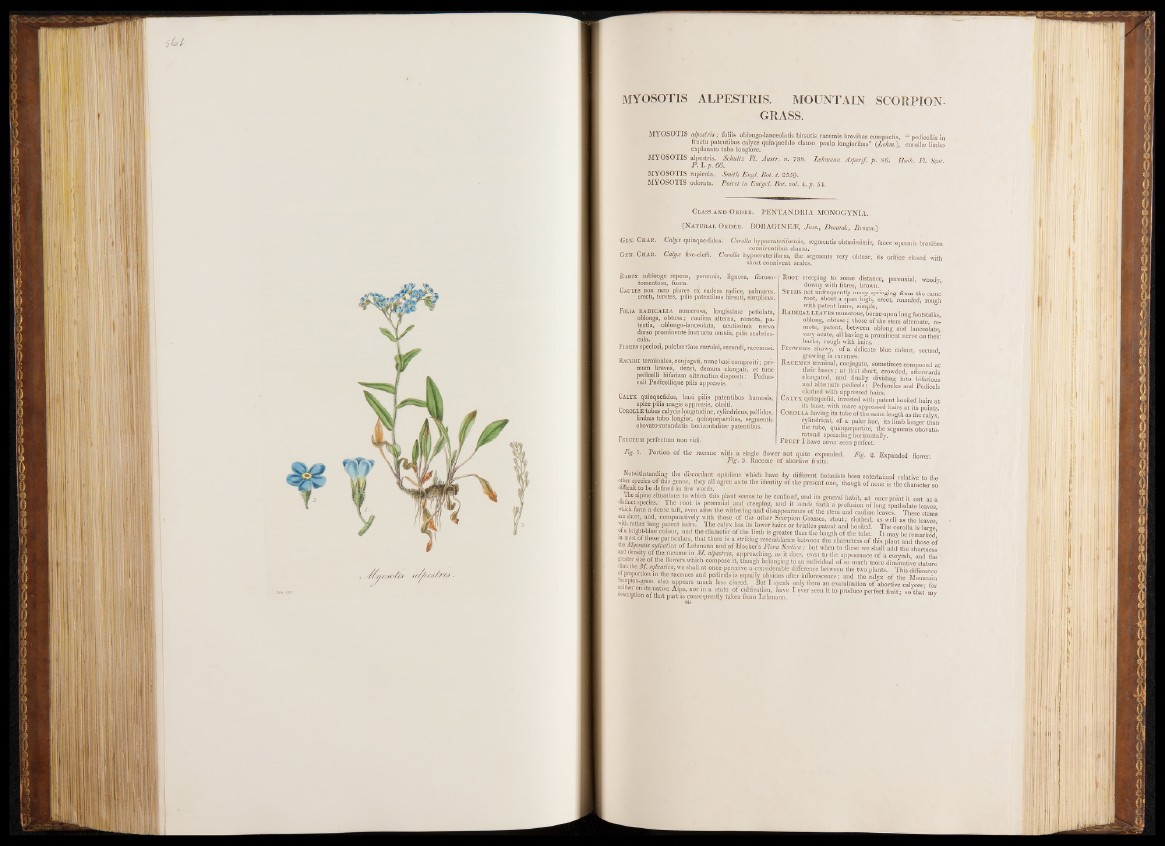
MYOSOTIS ALPESTRIS. MOUNTAIN SCORPION-
GRASS.
MYOSOTIS alpest ris ; foliis oblongo-lanceolatis hirsutis racemis brevibus compactis, “ pedicellis in
fructu patentibus calyce quinquefido clauso paulo longioribus” (Lehm.), corollæ limbo
explanato tubo longiore.
MYOSOTIS alpestris. Schultz Fl. Austr. n. 7 88. Lehmann Asperif. p. 86. Hook. Fl. Scot.
P. I. p . 66.
MYOSOTIS rupicola. Smith Engl. Bot. t. 2559* j
MYOSOTIS odorata. Poiret in Encycl. Bot. vol, 4. p. 5 4 .
Class a n d Ord e r . PENTANDRIA MQNOGYNIA.
; [N atural Ord e r . BORAGINEA5, Juss., Decand., Brown.)
GEN. Cha r. Calyx quinque-iidus. Corolla hypocrateriformis, segmentis obtusissimis, fauce squamis brevibus
conniventibus clausa.
Gen. Char. Calyx five-cleft. Corolla hypocrateriform, the segments very obtuse, its orifice closed with
short connivent scales.
Radix sublonge repens, perennis, lignosa, fibroso-
toraentosa, fusca.
CAULES non raro plures ex eadem radice, palmares,
erecti, tereteSj pilis patentibus hirsuti, simplices.
Folia radicalia numerosa, longissime petiolata,
oblonga, obtusa; caulina alterna, remota, pa-
tentia, oblongo-lanceolata, acutissima nervo
dorso prominente instructa omnia, pilis scabrius-
cula.
Flores speciosi, pulcherrime casrulei, secundi, racemosi.
Racemi terminates, conjugati, nunc basi compositi; pri-
mum breves, densi, demum elongati, et tunc
pedicelli bifariam alternatim dispositi: Pedun-
culi Pedicellique pilis appressis. -
Calyx quinquefidus, basi pilis patentibus hamosis,
apice pilis magis appressis, obsiti.
Corollas tubus calycis longitudine, cylindricus,pallidus,
limbus tubo longior, quinquepartitus, segmentis
obovato-rotundatis horizontaliter patentibus.
Fructum perfectum non vidi.’
Pig. ;1. Portion of the raceme with a single fk»v
Fig. 3. Raceme
Root creeping to some distance, perennial, woody,
downy with fibres, brown.
Stems not unfrequently many springing from the same
root, about a span high, erect, rounded, rough
with patent hairs, simple.
Radical leaves numerous, borne upon long footstalks,
oblong, obtuse; those of the stem alternate, remote,
patent, between oblong and lanceolate,
very acute, all having a prominent nerve on their
backs, rough with hairs. .
F lowers showy, of a delicate blue colour, secund,
growing in racemes.
Racemes terminal, conjugate, sometimes compound at
their bases; at first short, crowded, afterwards
elongated, and finally dividing into bifarious
and alternate pedicels: Peduncles and Pedicels
clothed with appressed hairs.
Calyx quinquefid, invested with patent hooked hairs at
its base, with more appressed hairs at its points.
Corolla having its tube of the same length as the calyx,
cylindrical, of a paler hue, its limb longer than
the tube, quinquepartite, the segments obovato-
rotund spreading horizontally.
Fr u it I have never seen perfect.
m o t quite expanded. Fig. 2 . Expanded flower.
of abortive fruits.
— ------------ .....— ......... ........ wj umcicui uuuunsis ueen entertained relative to the
«her species of this genus, they all agree as to the identity of the present one, though of none is the character
clinicult to be, defined in few words.' 1
T|e alpine situations to which this plant seems to he confined, and its general habit, at once point it out as a
distinct species. The root is perennial, and creeping, and it sends forth a profusion of long spathulate leaves
»Inch form a dense tuft, even after the withering and disappearance of the stem and cauline leaves. These stems
are Sjo* and, comparatively with those of the other Scorpion Grasses, stout; dotlied, as well as the leaves
with rather long patent hairs. The calyx has its lower hairs or bristles patent and hooked. The corolla is large’
ot a bright-blue colour, and the diameter o f the limb is greater than the length of the tube. It may be remarked’
m most of these particulars, that there is a striking resemblance between the characters of this plant and those of
tHe Mt/osotis sylputwa of Lehmann and of Hooker’s Flora Scotica; but when to these ive shall add the shortness
and density of the raceme in M, alpestris, approaching, as it does, even to the appearance of a corymb and the '
I H l “ of l,he 9mrers compose it, though belonging to an individual of so much more diminutive stature
man me Ills sylvatwa, we shall at once perceive a considerable difference between the two plants. This difference
«proportion in the racemes and pedicels is equally obvious after inflorescence; and the calyx of the Mountain
ocorpioa-grass also appears much less closed. But 1 speak only from an examination of abortive calyces- for ■HI ,ty “ ,e A1I?S> nor a s,ttte ,of cultivation, have I ever seen it to produce perfect fruit; so that my
description of that part is consequently taken from Lehmann. ' ^